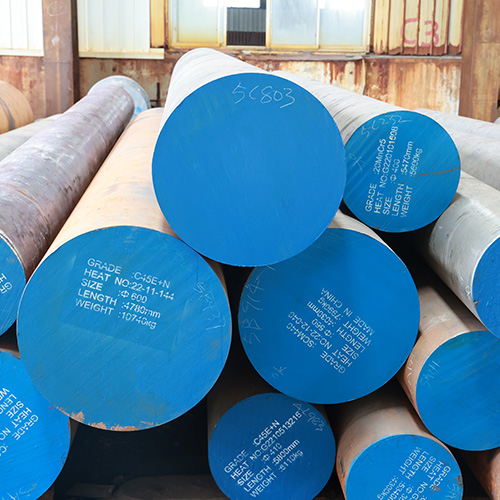Introduction

C45 steel, also known as 1045 steel or S45C, is a versatile medium-carbon steel that has found widespread application in various industries. Its unique blend of properties makes it an ideal choice for a multitude of applications, ranging from automotive components to construction materials. In this blog post, we will delve into the characteristics, benefits, and applications of C45 steel, providing a comprehensive overview of its advantages.
Understanding C45 Steel
C45 steel is a medium-carbon steel, meaning it has a carbon content ranging from 0.42% to 0.50%. This carbon content provides a good balance of strength, toughness, and machinability, making it a versatile material for a variety of applications. Other alloying elements present in 1045 steel include manganese, silicon, phosphorus, and sulfur. These elements contribute to the overall properties of the steel, such as its hardness, ductility, and resistance to corrosion.
The Advantages of C45 Steel
Excellent Machinability: C45 steel is renowned for its exceptional machinability, which means it can be easily cut, drilled, and shaped using standard machining techniques. This makes it a cost-effective material for manufacturing components with complex geometries, such as gears, shafts, and connecting rods.
High Strength and Toughness: The medium carbon content of 1045 steel provides a good balance of strength and toughness. This makes it suitable for applications that require both high strength and resistance to impact loads, such as automotive components, construction materials, and agricultural equipment.
Good Weldability: 1045 steel is highly weldable, making it easy to join components together using welding techniques. This is particularly useful in fabricating large structures or repairing damaged parts, such as in the construction industry or manufacturing of heavy machinery.
Cost-Effective: C45 steel is a relatively inexpensive material compared to other alloy steels, making it a cost-effective choice for many applications. This is especially beneficial for manufacturers who need to produce large quantities of components at a competitive price.
Heat Treatable: 1045 steel can be heat treated to achieve specific properties, such as increased hardness, strength, or wear resistance. Heat treatments such as quenching and tempering can be used to tailor the properties of the steel to meet the requirements of a particular application.
Applications of C45 Steel
C45 steel finds applications in a wide range of industries, including:
- Automotive Industry: 1045 steel is used to manufacture various automotive components, such as gears, shafts, connecting rods, and suspension parts. Its excellent machinability, strength, and toughness make it an ideal choice for these components.
- Construction Industry: 1045 steel is used in the construction of buildings and bridges due to its high strength and weldability. It is often used for structural components such as beams, columns, and connections.
- Mechanical Engineering: 1045 steel is used to manufacture machine components such as bearings, gears, and shafts. Its excellent mechanical properties and durability make it a reliable choice for these applications.
- Agricultural Equipment: 1045 steel is used to manufacture agricultural equipment due to its durability and resistance to wear. It is commonly used for components such as tractor parts, implements, and machinery frames.
Table: Comparison of C45 Steel with Other Steels
| Property | C45 Steel | Low Carbon Steel | High Carbon Steel | Alloy Steel |
|---|---|---|---|---|
| Carbon Content | 0.42-0.50% | < 0.3% | > 0.6% | Varies |
| Strength | Medium | Low | High | High |
| Toughness | Medium | High | Low | High |
| Machinability | Excellent | Excellent | Poor | Varies |
| Weldability | Good | Good | Poor | Varies |
| Cost | Moderate | Low | High | High |
Heat Treatment of C45 Steel

Heat treatment is a critical process for enhancing the properties of 1045 steel. Common heat treatments include:
- Annealing: This process softens the steel and improves its machinability, making it easier to process and shape.
- Normalizing: This process refines the grain structure and improves the mechanical properties of the steel, such as its strength and toughness.
- Quenching and Tempering: This process is used to increase the hardness and strength of the steel, making it suitable for applications that require high wear resistance or impact resistance.
Conclusion
C45 steel is a versatile and cost-effective material that offers a good balance of strength, toughness, and machinability. Its wide range of applications makes it an essential material in many industries, from automotive to construction and mechanical engineering. By understanding the properties and benefits of 1045 steel, engineers and manufacturers can make informed decisions about its use in their products.
FAQ
What is the difference between C45 steel and AISI 1045 steel?
C45 steel and AISI 1045 steel are essentially the same material. The only difference is the designation system used. C45 is the designation commonly used in Europe, while AISI 1045 is used in the United States.
Can 1045 steel be welded?
Yes, 1045 steel is highly weldable, making it easy to join components together using welding techniques.
What is the best heat treatment for C45 steel?
The best heat treatment for C45 steel depends on the desired properties. Quenching and tempering is commonly used to increase hardness and strength, while annealing is used to improve machinability.
What are the common applications of C45 steel?
C45 steel is used in a wide range of applications, including automotive components, construction materials, machine components, and agricultural equipment.
